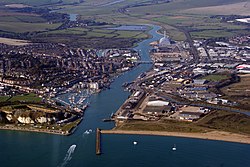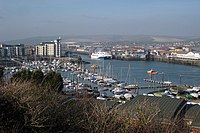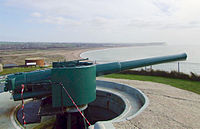Newhaven
| Newhaven | |
| Sussex | |
|---|---|
 Newhaven from the air | |
| Location | |
| Grid reference: | TQ449016 |
| Location: | 50°48’-0"N, 0°3’36"E |
| Data | |
| Population: | 12,250 (2011) |
| Post town: | Newhaven |
| Postcode: | BN9 |
| Dialling code: | 01273 |
| Local Government | |
| Council: | Lewes |
| Parliamentary constituency: |
Lewes |
| Website: | Newhaven Town Council |
Newhaven is a busy port town in Sussex. It sits at the mouth of the River Ouse, on the English Channel coast, and is a ferry port for services to France.
The main part of the town is located on the west side of the river, there is also a residential area at Denton and Mount Pleasant on the slopes of the Downs to the east. Industrial areas lay on the east side of the river as does all three of the railway stations which serve Newhaven; Newhaven Town, Newhaven Harbour and the now redundant Newhaven Marine. Recent housing development has taken place at the West Quay, Harbour Heights and August Fields.
Contents
Origins
Newhaven lies at the mouth of the River Ouse, in the valley the river has cut through the South Downs. Over the centuries the river has migrated between Newhaven and Seaford in response to the growth and decay of a shingle spit (shoal) at its mouth.
There was a Bronze Age fort on what is now Castle Hill.[1]
In about 480 AD Saxon folk established a village near where Newhaven now stands, which they named "Meeching" (variously known as "Myching" or "Mitching").[2]
Throughout the Middle Ages, the main outlet and port of the Ouse was at Seaford (a limb of the Cinque Ports).
The growth of the shingle spit hindered the outflow of the river, which consequently flooded the Levels upstream and hindered access to the port. Therefore, a channel through the shingle spit was cut in the mid-16th century below Castle Hill, creating access to a sheltered harbour, better than that at Seaford.[2][3] This was the origin of modern Newhaven.
However, shingle continued to accumulate and so the mouth of the Ouse began to migrate eastwards again. Under the Ouse Navigation Act (1790), a western breakwater was built to arrest longshore drift and so cut off the supply of shingle to the spit.[4] A new outlet (The Cut) was built on the river's present course, below Castle Hill. At that time the settlement began to be known as the "new haven". The present breakwater was built in 1890.
Port
Although there are some signs of the derlict facilities that serviced the former train ferry operations, the port still sees a great deal of freight and passengers movement.[5] International ferries run to the French port of Dieppe, Seine-Maritime, operated by LD Lines.[6] Currently there are two sailings per day, one in the morning and one in the evening, using the 18,654 GT ro-ro MS Seven Sisters. Rail passengers wishing to connect with the ferries are advised nationally to travel to Newhaven Town, and then use the free bus service; this has resulted in a dramatic fall in passenger services at Newhaven Harbour.
In 2011, Sussex Yachts Ltd initiated a scheme to regenerate the East Quay with their yacht refit business, opening Newhaven Boatyard the largest marine refit facility in the South East. The project expanded into commercial vessel maintenance and refit in 2012.[7]
The port is the proposed main landside site for E.ON's development of the offshore-Rampion Wind Farm.[8]
History
The village was of little maritime importance until the opening of the railway line to Lewes in 1847. The London Brighton and South Coast Railway (LB&SCR) constructed their own wharf and facilities on the east side of the river, and opened the Newhaven harbour railway station. The railway also funded the dredging of the channel and other improvements to the harbour between 1850 and 1878, to enable it to be used by cross channel ferries,[9] and in 1863 the LB&SCR and the Chemin de Fer de l'Ouest introduced the Newhaven-Dieppe passenger service.[10] The harbour was officially recognised as 'The Port of Newhaven' in 1882.[11] Imports then included French farm products and manufactures, timber, granite and slates.[12]
Newhaven harbour was designated as the principal port for the movement of men and materiel to the European continent during World War I and was taken over by the military authorities and the ferries requisitioned for the duration of the war. Between 22 September 1916 and 2 December 1918, the port and town of Newhaven were designated a 'Special Military Area' under the 'Defence of the Realm Regulations', and the Harbour station was closed to the public.[13] The port and harbour facilities, rail sidings and warehousing were greatly enlarged at this time and electric lighting installed to allow for 24-hour operation.
During Second World War, large numbers of Canadian troops were stationed at Newhaven, and the vast, bloody Dieppe Raid in 1942 was largely launched from the harbour.
Lifeboat
The Newhaven Lifeboat, the first of which was commissioned in 1803, is among the oldest in Britain, and was established some 20 years before the Royal National Lifeboat Institution. The town established the rescue lifeboat in response to the wreck of HMS Brazen in January 1800 when only one man of her crew of some 105 men could be saved.[14] The town used a combination of funds raised locally and contributed by Lloyd's of London to purchase a lifeboat built to Henry Greathead's "Original" design. Newhaven also has one of the Watch stations of the National Coastwatch Institution.[15]
Industry
To the east, in the neighbouring parish of Seaford was the village of Tide Mills, built in 1761, and now derelict. Here are the remains of workers' cottages, the tide mill itself, and a large saline lagoon which was the storage pond for high water to power the mills on the outgoing tide.
The Newhaven Marconi Radio Station was established in 1904, and started running in 1905. The station was owned and operated by the Marconi Radio Company and achieved regular ship to shore radio communications in approximately 1912.
The Heritage Marine Hospital was built in 1924 to cater for disabled boys who had undergone surgery. It became a casualty of wartime defence work during Second World War.
Today, the Denton Island Business Park lies to the north of the town on the east bank of the river. The business park has attracted a number of businesses to the area with the basepoint Newhaven Enterprise Centre being the focal point. The centre has attracted a lot of new businesses to the area.
Military
Newhaven Fort,[16] one of the Palmerston Forts, was built on Castle Hill on the recommendation of the 1859 Royal Commission to defend the growing harbour. It was the largest defense work ever built in Sussex and is now open as a museum.
The adjacent village of Tide Mills was the site of an experimental seaplane base at the head of the beach. The first formation of No. 242 Squadron RAF was on 15 August 1918 from numbers 408, 409 and 514 Flights at the seaplane station at New haven, Sussex. Operating from there and the nearby airfield at Telscombe, it was equipped with Short Type 184 seaplanes and carried out anti-submarine patrols over the English Channel until the end of the First World War. Surveys carried out in 2006 have exposed part of the slipway, concrete aprons to both hangars with door tracks and several other slabs presumed to be workshops. Sussex Archaeological Society started a dig in April 2006 to cataloger the entire East Beach site.
Sights of the town
The main landmark in the town is the Newhaven Fort. The new waste incinerator is a major landmark, the chimney being visible from the sea as well as from Firle Beacon and parts of Seaford.
The parish includes part of the Brighton to Newhaven Cliffs Site of Special Scientific Interest. The cliffs are mainly of geological interest, containing many Santonian and Campanian fossils. The SSSI listing includes flora and fauna biological interest too.[17]
The open land surrounding Newhaven to the west, north and east is part of the South Downs National Park, although the town itself is excluded from the boundaries.
Sport
As might be expected with its proximity to the sea, Newhaven is home to a thriving marina: the Newhaven and Seaford Sailing Club[18] is based there; Scuba diving, water ski-ing and surfboarding are also practised.
- Archery: Newhaven Archery Club
- Football: Newhaven FC
The town also enjoys a large and modern indoor bowls centre, and there is a thriving outdoor bowling green located close to the marina.
Outside links
- Newhaven Chamber of Commerce
- Newhaven Town Website, Swing Bridge times, tides, trains, weather, business directory etc
- Our Newhaven website; a volunteer run, community driven, 'living history' project
References
- ↑ Newhaven Fort - History
- ↑ 2.0 2.1 Newhaven, A History of the County of Sussex: Volume 7
- ↑ Brandon, P. and Short, B., 1990: The South-East from AD 1000. Longman.
- ↑ Woodcock, A., 2003: The archaeological implications of coastal change in Sussex. pp1-16 in Rudling, D., (ed.), The Archaeology of Sussex to AD2000. Heritage, University of Sussex.
- ↑ Set of photographs of Newhaven Harbour
- ↑ Newhaven ferries
- ↑ Sussex Yachts Ltd
- ↑ "Newhaven Port reveals how the Rampion wind farm will help secure its future". Sussex Express. 12 October 2012. http://www.sussexexpress.co.uk/news/local/newhaven-port-reveals-how-the-rampion-wind-farm-will-help-secure-its-future-1-4359188. Retrieved 10 February 2013.
- ↑ Pratt, Edwin (1921). British railways and the Great War. Selwyn & Blount. p.1032-3.
- ↑ Jordan, S (1998). Ferry Services of the London, Brighton & South Coast Railway. Usk: The Oakwood Press. ISBN 0-85361-521-7..
- ↑ The Official Guide to the London Brighton and South Coast Railway. Cassell. 1912. pp. 260–2..
- ↑ Official Guide to the London Brighton and South Coast Railway, (1912) 260-2.
- ↑ Pratt, British railways and the Great War, p.1033.
- ↑ Newhaven Lifeboat
- ↑ Newhaven NCI
- ↑ New haven Fort
- ↑ "Natural England - SSSI". English Nature. http://www.english-nature.org.uk/special/sssi/sssi_details.cfm?sssi_id=1003033. Retrieved 2008-06-19.
- ↑ NSSC

